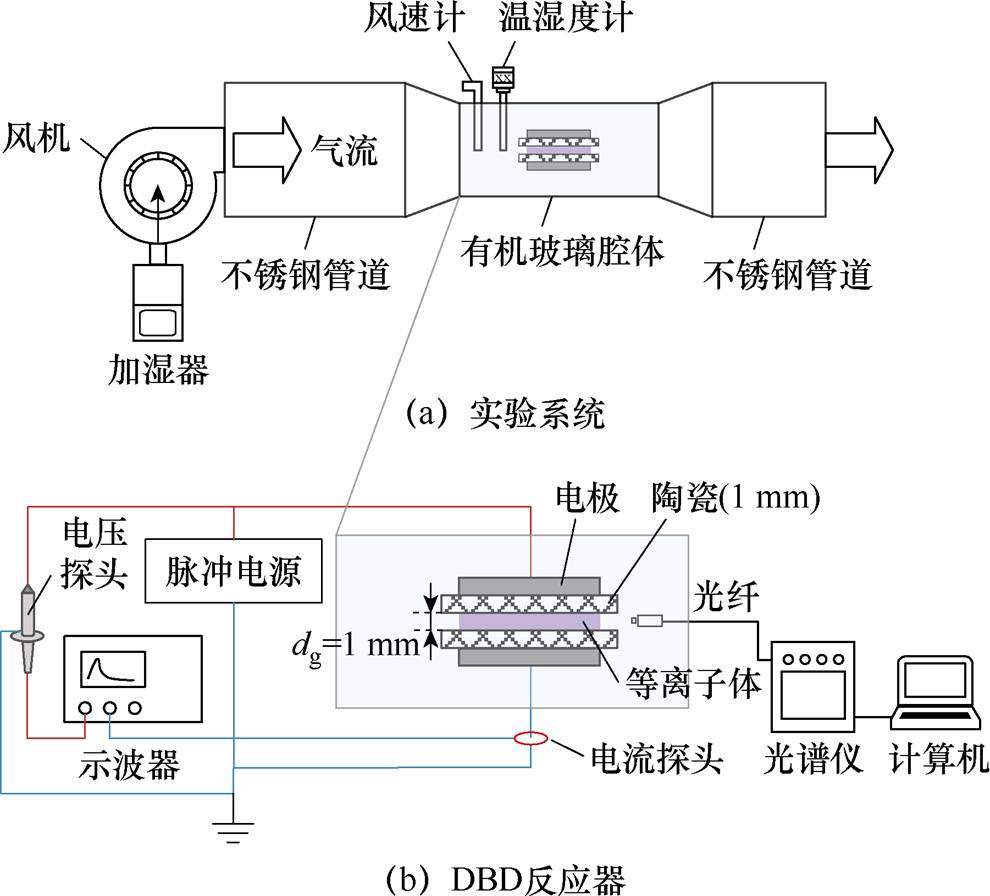
图1 实验系统和DBD反应器示意图
Fig.1 The experimental system and the schematic of the DBD reactor
摘要 该文主要研究大气压湿空气条件下纳秒脉冲平行平板介质阻挡放电(DBD)的放电和发射光谱特性。首先,基于DBD等效电路模型计算得到了脉冲上升沿和下降沿阶段的气隙击穿电压。特别地,随着脉冲上升和下降时间的增大(50~500 ns),上升沿击穿电压降低,而下降沿击穿电压先降低后增加,由此导致放电功率和氮气谱线强度在200~300 ns范围内存在极小值。并且发现击穿电压与湿度近似呈线性关系,拟合得到完全干燥空气的上升沿击穿电压为7.19 kV(1 mm气隙),且相对湿度每上升20%,击穿电压提高0.14 kV。在给定实验参数范围下,氮气分子的发射光谱强度与放电功率近似成正比,而受具体脉冲参数的影响较小,表明放电功率对放电产物的线性调控作用。最后,基于流注理论提出了简化模型用于估算纳秒脉冲放电的击穿电压。
关键词:大气压 湿空气 纳秒脉冲 介质阻挡放电(DBD)
介质阻挡放电(Dielectric Barrier Discharge, DBD)是在大气压条件下获得低温非热等离子体的主要方式之一,近年来在微纳材料制备[1]、气体污染物降解[2-4]、杀菌消毒[5-7]、生物医学[8-9]、固氮[10]、二氧化碳转化[11-13]等领域展现出良好的应用前景。与常规的交流放电相比,纳秒脉冲放电具有低热效应[14-15]、高放电均匀性[15-16]、高电子能量和活性粒子产率[17-19]等优势,受到国内外学者的广泛研究和关注。
纳秒脉冲可调参数较多,如极性、上升沿/下降沿时间、脉宽、频率等,这些参数均会影响放电特性(电压电流、放电功率、气体击穿特性、气体绝缘恢复特性等)和放电活性产物(激发态粒子、活性氧和活性氮粒子等)。研究表明,随着电压上升速率的提高,无论气体种类、放电形式(如平行平板电极、针-板电极、DBD、大气压等离子体射流等),气隙的击穿电压和活性粒子的产生效率均随之提 高[20-24]。这是因为纳秒脉冲放电存在放电时延,电压上升速率越高,虽然击穿时刻提前,但击穿时的电压更高,从而导致能量注入增加、电子密度和电子温度升高,以及活性粒子密度增大。在重复频率放电中,脉冲频率也会影响放电特性。实验[25-27]和仿真[28]研究均表明,在一定频率范围内,随着频率的升高,单脉冲的击穿电压和沉积能量会下降。这一现象通常解释为,频率升高会导致残余电荷和亚稳态粒子密度升高,即预电离水平提高,从而降低击穿电压。由此可见,击穿电压是影响放电特性和放电产物的关键参量。需要指出的是,以往研究通常仅改变单一变量,未综合比较各个因素对击穿特性、放电产物的影响。此外,脉冲参数的改变会同时影响放电功率和放电产物,而不同脉冲参数下放电功率对放电产物的调控规律并不明确。评判放电状态和活性产物的常用方法是等离子体发射光谱,能够在一定程度上预测活性粒子状态和实际处理效 果[29-30]。因此,本文将重点研究不同脉冲参数,特别是不同放电功率下的等离子体发射光谱特性。
湿度是影响空气放电特性和放电活性产物的关键参量。放电特性方面,与氧气分子类似,水分子被认为是电负性气体,可发生电子附着反应[31];此外,水分子可参与氧气的三体附着反应,提高氧气分子的附着反应速率[32]。电子附着系数的增大会导致有效电离系数降低,从而致使气隙击穿电压升 高[33-34]。放电产物方面,研究表明,适当提高湿度可提高空气放电产生的羟基自由基含量[35-36],而羟基自由基被认为是湿度提升等离子体物表和气溶胶细菌杀灭效果的重要因子[36-40]。然而,对于纳秒脉冲介质阻挡放电(DBD),较少有文献研究空气湿度对放电特性(击穿电压等)和放电产物的影响,这是本文的研究重点之一。
本文结合电压电流数据、电路模型和放电功率计算、等离子体发射光谱,重点研究了电压幅值、上升沿、频率和气流相对湿度(Relative Humidity, RH)对单极性纳秒脉冲介质阻挡放电(DBD)和放电产物的影响。
本文采用的实验系统如图1a所示,由文献[40]的系统改造而成。DBD反应器(见图1b)放置于长方体有机玻璃腔体(内部截面尺寸为105 mm× 105 mm,长度为200 mm)中,腔体左侧接2 m长的圆形不锈钢管道,管道左侧接离心式风机,可以控制气流速度。本文中,腔体的入口风速固定为1 m/s,在较低风速范围内,气流对放电的影响可以忽略不计。通过调节入口的加湿器可以调节腔体内气流的湿度。入口气流温度为室温(25℃左右)。

图1 实验系统和DBD反应器示意图
Fig.1 The experimental system and the schematic of the DBD reactor
如图1b所示,DBD反应器采用经典的双介质阻挡方式,即高压和地电极各有介质覆盖。高压电极和地电极均为圆形,直径为50 mm,边缘倒角以降低电场畸变。介质采用氧化铝陶瓷,厚度为1 mm,介质片大于圆形电极,防止沿面放电。两个介质片之间放置标准石英垫片以控制气隙距离,石英垫片位于圆形电极外侧,不影响气隙内放电。为确保产生均匀放电,气隙距离设置为1 mm。驱动电源为HVP-20型单极性纳秒脉冲电源(西安灵枫源电子科技有限公司生产),脉冲上升沿/下降沿时间、频率和脉宽均可调。与交流电源相比,使用脉冲电源更易产生均匀放电[16]。放电功率由电压和电流积分得到,电压和电流分别使用高压探头(P6015A, Tektronix)和电流探头(TCP312A, Tektronix)测定。
本文主要研究电压幅值Vp、上升沿tr、频率f和气流相对湿度RH对放电特性和等离子体发射光谱的影响。标准参考实验条件设置为Vp=12 kV,tr=50 ns,f=2 kHz,RH=11%;其他参数为:下降沿50 ns、脉冲平顶区宽度100 ns。采用控制变量法研究各个因素的影响。
等离子体发射光谱可以表征等离子体产生的激发态粒子,也可间接表征短寿命活性粒子。等离子体发射光谱用光谱仪(AvaSpec-2048, Avantes)测定,波长范围为300~450 nm,曝光时间为1 s。光纤前配备准直镜,焦点位于气隙中央,光纤头距离气隙中央约为4 cm,在所有实验中,保持反应器和光纤位置不变。每个实验条件下的发射光谱采集60次,并计算平均值和标准差。本文标准实验条件下的等离子体发射光谱如图2所示。谱图以氮气第二正带系[41](C3Pu→B3Pg,Du=-3, -2, -1, 0, +1)为主,同时包含氮气离子的第一负带系(B2Su→X2Sg, 0-0, 391.4 nm)[42-43]。一般氮气离子谱线在高场强下才会出现[44]。391.4 nm处的发射谱线强度大约为377 nm处(最高峰)谱线强度的1%。此外,需要指出的是,本文中的谱图为时间积分结果,基于谱线比计算约化场强的方法可能并不适用。
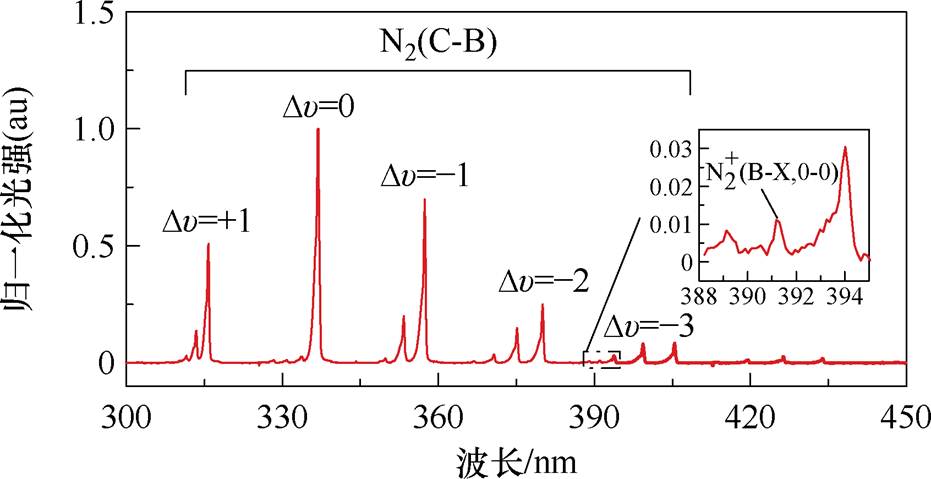
图2 本文标准实验条件下的等离子体发射光谱
Fig.2 The optical emission spectrum of plasma under the standard experimental condition in this work
对于均匀模式的DBD放电,其对应的电路模型如图3[45]所示。图中,Va和ia分别为外加电压和总电流,可由实验得到;Cd和Vd分别为陶瓷介质(两片)的等效电容和两端电压;Cg和Vg分别为气隙等效电容和气隙电压。空气间隙被击穿相当于开关闭合,此时放电可等效为时变阻性负载R,气隙等效为Cg和R的并联。陶瓷相对介电常数er=9.5,计算得到Cd=82.6 pF(上下共两块介质,总厚度dd= 2 mm);空气相对介电常数为1,计算得到Cg= 17.4 pF。
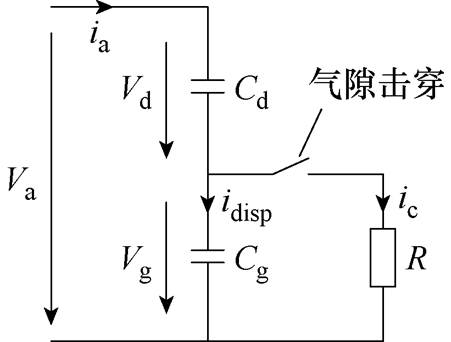
图3 均匀模式下的DBD等效电路
Fig.3 The equivalent circuit of homogeneous DBD
Vd和Vg计算公式为
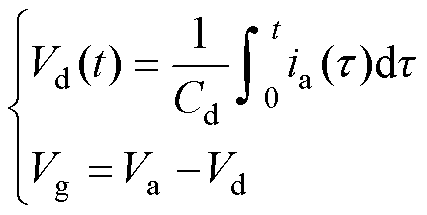 (1)
(1)
介质两端电压由电荷除以电容得到,电荷由电流积分得到。注意,此处不考虑介质表面的初始电荷,即认为在上一次放电中,上升沿和下降沿放电产生的电荷相互抵消。这一假设具有一定的合理性,因为以往研究表明,DBD上一次放电后的残余电场(由介质表面电荷引起)通常处于kV/cm的量级,且远小于外加电场的峰值[46]。更严谨的计算需要考虑介质初始表面电荷的影响。在式(1)的基础上可计算得到位移电流分量idisp和传导电流ig为
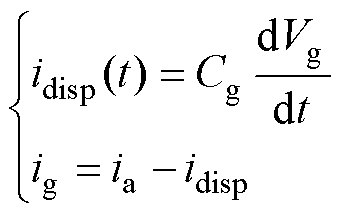 (2)
(2)
式中,位移电流为气隙电容导致的电流;传导电流为总电流减去位移电流。
典型的电压、电流波形及其分量如图4所示。从传导电流可以看到,一个脉冲下共有两次放电,一次在上升沿,一次在下降沿,这是单极性脉冲放电的典型特征[45]。气隙击穿的判定标准是气隙电压突然下降而电流突然上升,如图4所示,电压上升沿过程中气隙击穿时刻为24 ns左右,击穿时刻的气隙电压为7.2 kV左右,即为上升沿对应的击穿电压Vb1;同样可得到下降沿击穿电压Vb2。在计算时,上升沿和下降沿击穿电压可分别取气隙电压Vg在上升沿和下降沿阶段的峰值。对于图4的结果,上升沿击穿电压为7.2 kV,与静态击穿电压(1 mm间隙,RH=11%,理论应接近3 kV)相比,过电压倍数约为2.4。M. S. Simeni等基于四波混频法测得,在电场强度增长率约为13 kV/(cm·ns)时,大气压空气DBD的气隙击穿场强约为75 kV/cm[47]。Cui Yingzhe等基于电场诱导二次谐波法测得,在电场强度增长率约为0.2~0.4 kV/(cm·ns)条件下,大气压空气DBD的气隙击穿场强为43~50 kV/cm[48]。图4的气隙场强增长率约为2 kV/(cm·ns),若不考虑空间电荷和介质表面电荷,则击穿场强应为72 kV/cm,与M. S. Simeni等的研究结果相比偏高。
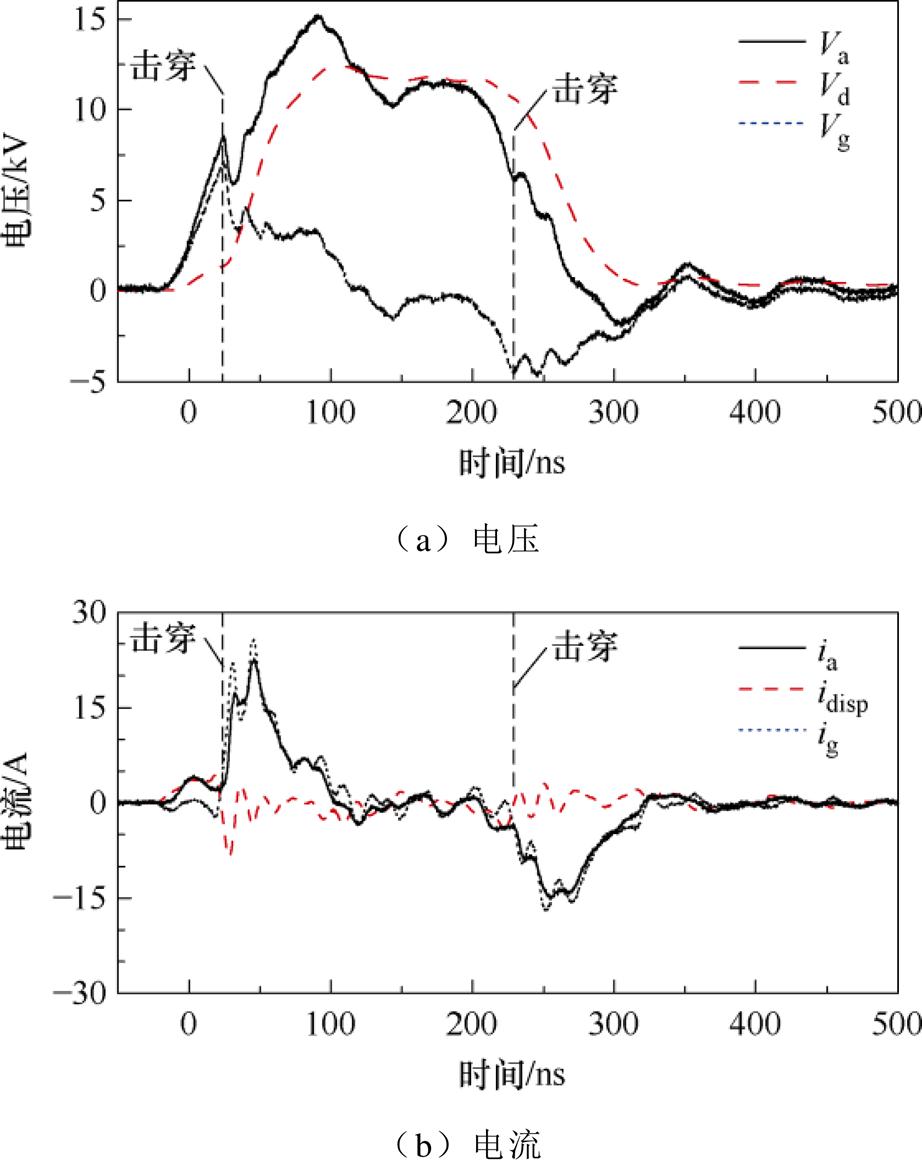
图4 典型电压、电流波形及其分量
Fig.4 Typical voltage and current waveforms and the corresponding voltage and current components
需要指出的是,24 ns放电之前理论上位移电流和总电流相同,但实际由于电路杂散参数等因素的影响,计算得到的位移电流和总电流不会完全重合。此外,从图4中可以看出,传导电流在上升沿阶段存在两个峰值,第一个峰是因为气隙击穿,即击穿后外加电压和气隙电压跌落,从而导致电流有一定降低,而随着外加电压的持续提升,气隙电场强度增加,此时传导电流会继续提升,出现第二个电流峰;之后随着介质表面电荷的累积,气隙电场会被介质表面电荷形成的反向电场削弱,导致放电被迫熄灭,传导电流逐渐恢复到零。下降沿与上升沿放电过程类似。
脉冲击穿具有一定的分散性,使用示波器采集100个脉冲的电压电流波形,然后进行统计分析,得到上升沿和下降沿击穿电压的平均值和标准差,并进行后续分析。
不同电压幅值下的电压和电流波形(带误差棒区域)如图5所示,图中每个条件下的波形均包含了100次测量的平均值(实线)和对应的误差棒区域(平均值±标准差,下同)。这里的电压幅值为电源设置的电压幅值,近似为脉冲平顶阶段(100 ns宽)的电压平均值。从图5中可以看出,相同参数下的电压和电流波形均具有较高的一致性,分散性不大。
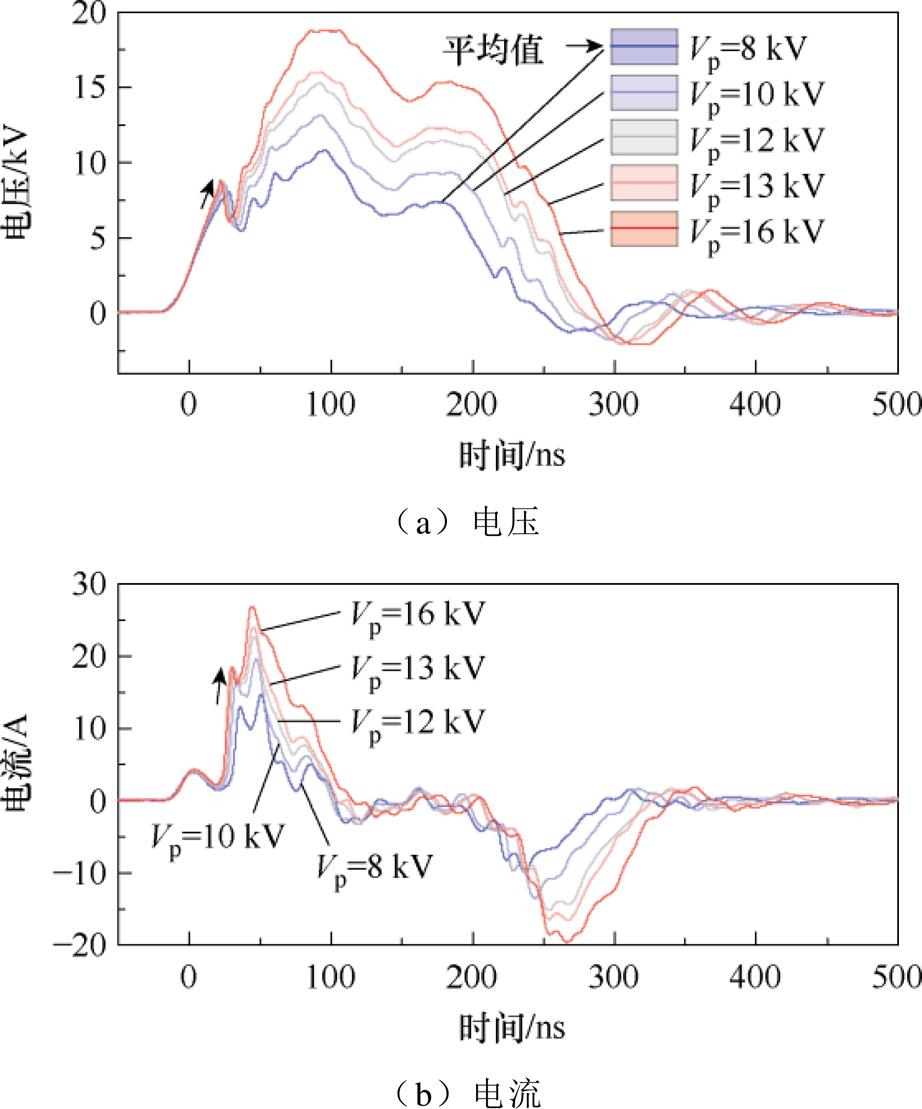
图5 不同电压幅值下的电压、电流波形
Fig.5 Voltage and current waveforms under different voltage amplitudes
电压幅值对上升沿和下降沿击穿电压、放电功率和谱线强度的影响如图6所示,随着外加电压峰值的增加,上升沿和下降沿阶段的气隙击穿电压均增加,所有条件下击穿电压的标准差小于0.1 kV。当脉冲峰值电压由8 kV增加到16 kV时,上升沿击穿电压由6.8 kV提高至7.5 kV,下降沿击穿电压由3.7 kV提高至6.9 kV,放电功率由6.1 W提高至23 W。放电功率近似和电压幅值呈线性关系(拟合优度R2=0.985)。
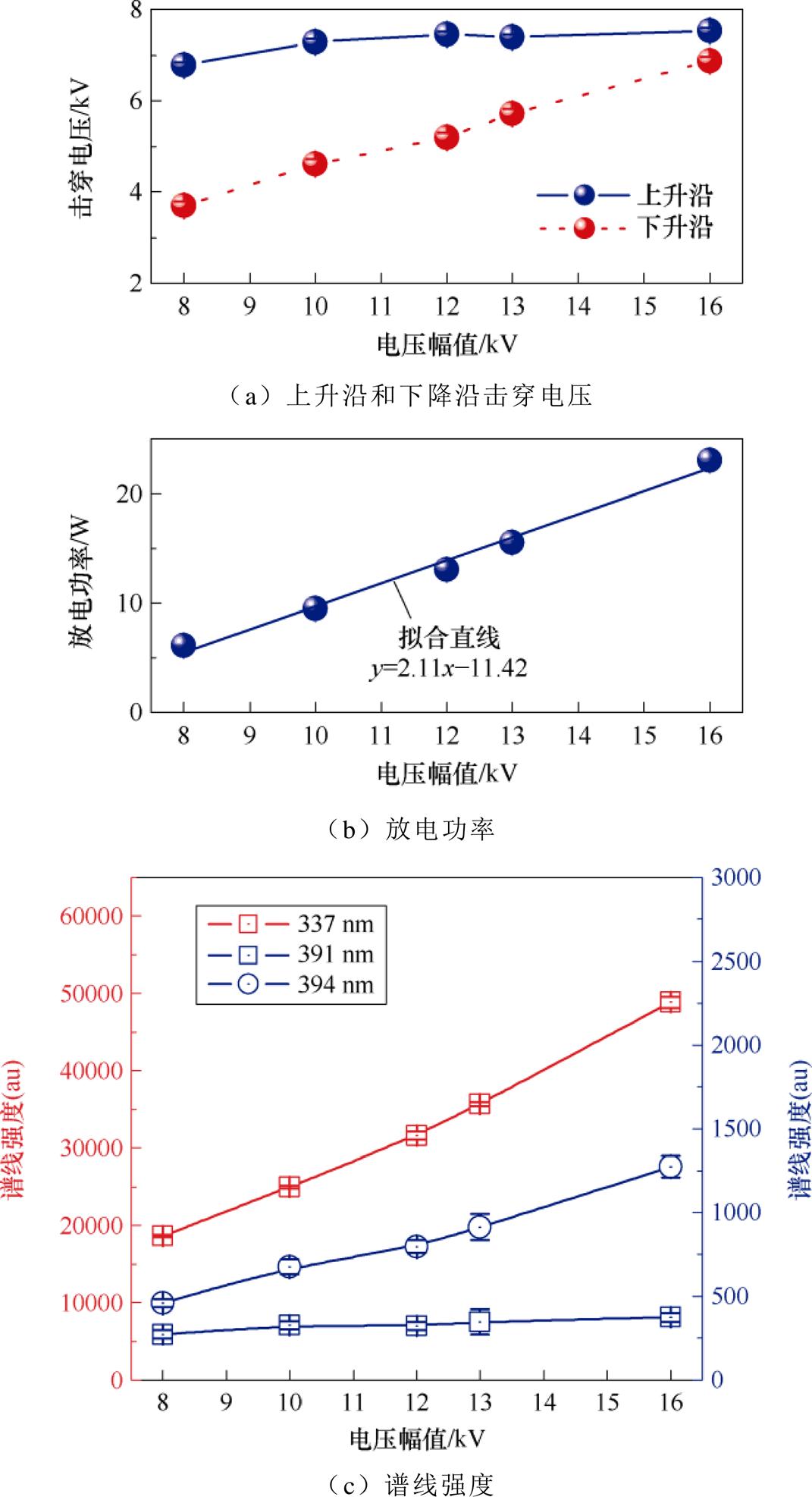
图6 电压幅值对上升沿和下降沿击穿电压、放电功率和谱线强度的影响
Fig.6 Breakdown voltages discharge power and emission intensities as a function of voltage amplitude
用337、391、394 nm附近最高峰的强度分别代表N2(C-B)的(0-0)、 (B-X)的(0-0)、N2(C-B)的(0-2)谱带强度。如图6c所示,337和394 nm对应的谱线强度近似与电压幅值呈线性关系(R2分别为0.989和0.981),而391 nm对应的氮气离子谱带强度呈现一定的饱和趋势(线性拟合R2=0.854)。可能的原因是,随着击穿电压和放电功率的提高,介质表面积累电荷量提高,电荷电场对外加电场的削弱作用更强,导致电离速率的提高没有激发速率的提高显著。
(B-X)的(0-0)、N2(C-B)的(0-2)谱带强度。如图6c所示,337和394 nm对应的谱线强度近似与电压幅值呈线性关系(R2分别为0.989和0.981),而391 nm对应的氮气离子谱带强度呈现一定的饱和趋势(线性拟合R2=0.854)。可能的原因是,随着击穿电压和放电功率的提高,介质表面积累电荷量提高,电荷电场对外加电场的削弱作用更强,导致电离速率的提高没有激发速率的提高显著。
不同脉冲上升时间下的电压、电流波形如图7所示,随着脉冲上升时间的降低,击穿时刻延迟,击穿时刻的电压降低,相应的电流也显著降低,如上升沿时间tr由50 ns增加到500 ns,峰值电流由22.2 A下降到4.8 A。整体而言,电压和电流的分散性较小。
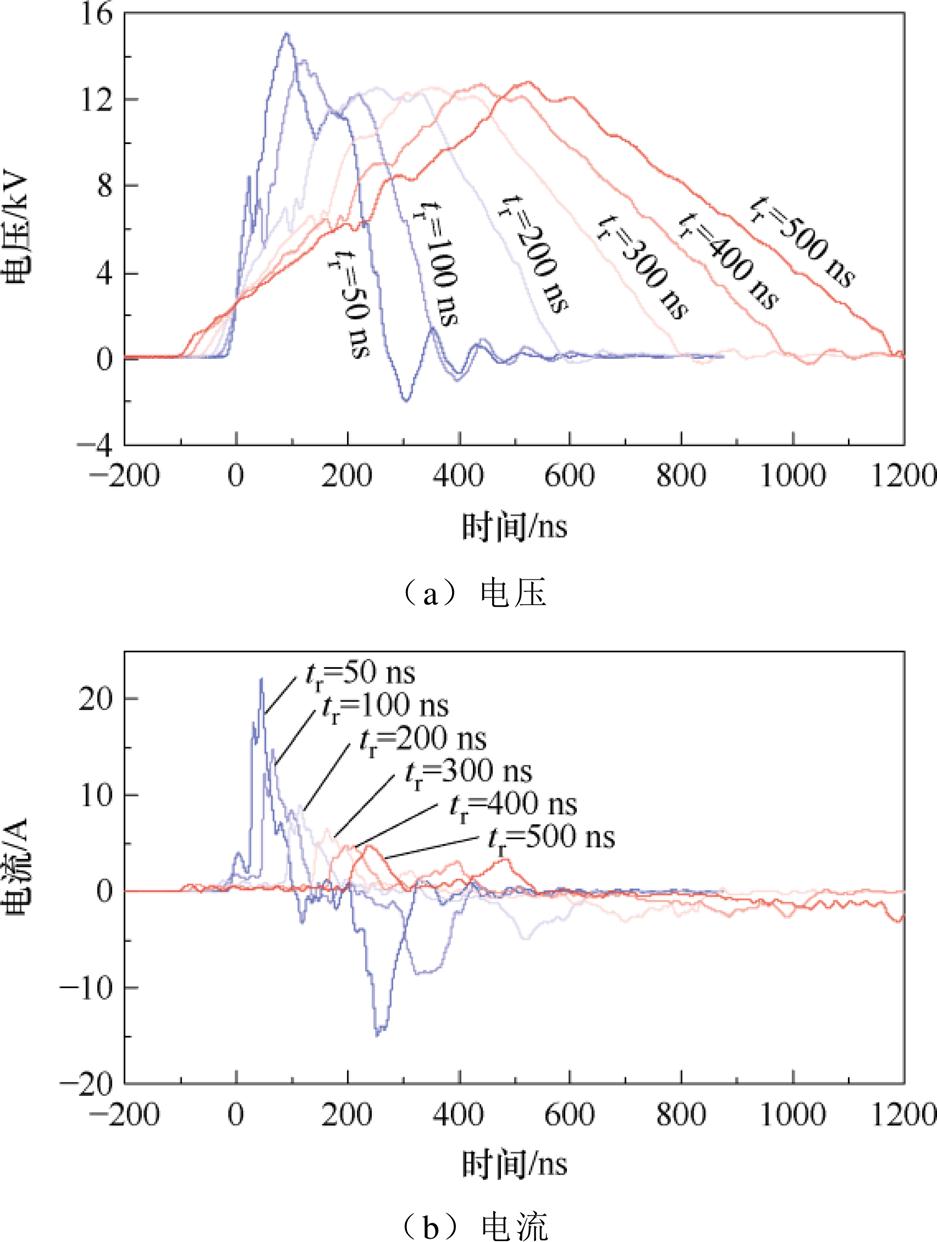
图7 不同脉冲上升时间下的电压、电流波形
Fig.7 Voltage and current waveforms under different pulse rise time
脉冲上升沿时间对上升沿和下降沿击穿电压、放电功率和谱线强度的影响如图8所示。如图8a所示,当脉冲上升沿时间从50 ns增加到500 ns,气隙的上升沿击穿电压由7.2 kV降低至5.0 kV。增大上升沿时间与减小峰值电压的效果相同,当上升沿增加时,电压上升的速率减小,导致气隙在更低的电压下被击穿。此外,发现下降沿击穿电压随上升沿先减小后增加,这也导致放电功率在200~300 ns范围内存在极小值(见图8b)。在50~200 ns参数范围内,下降沿击穿电压的降低同样可以归因于电压变化速率的影响;而在300~500 ns范围内,击穿电压的升高可能是由于上升沿与下降沿的时间间隔更长,导致气体绝缘逐渐恢复(气体密度恢复和电中性恢复),从而使下降沿的击穿电压得以回升。从这一角度来看,下降沿放电过程更加复杂,因为其会受到上升沿放电的影响。图8c的三条谱线的变化趋势与功率的变化趋势一致,可以印证电压、电流和功率测量结果的准确性。
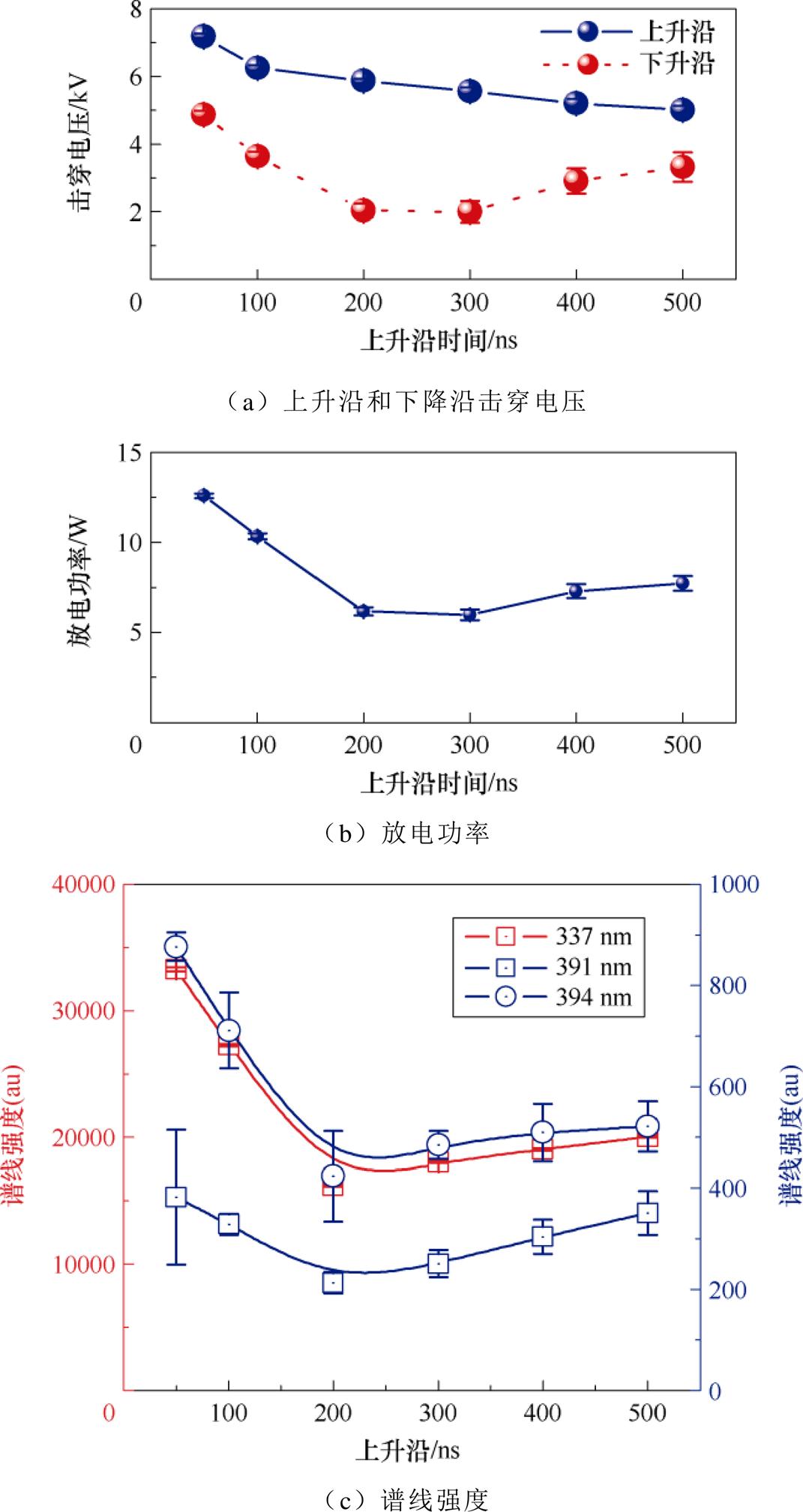
图8 脉冲上升沿时间对上升沿和下降沿击穿电压、放电功率和谱线强度的影响
Fig.8 Breakdown voltages, discharge power, and emission intensities as a function of pulse rise time
不同脉冲频率下的电压和电流波形如图9所示,随着频率提升,气隙击穿时刻提前,击穿电压和峰值电流均有所下降,与以往文献一致[26]。
脉冲频率对上升沿和下降沿击穿电压、放电功率和谱线强度的影响如图10所示。如图10a所示,频率由0.5 kHz上升到5 kHz,上升沿击穿电压由7.4 kV下降到6.9 kV,下降沿击穿电压由5.4 kV下降到4.6 kV。如图10b所示,随着频率升高,放电功率与频率之间脱离线性关系,单脉冲能量降低。三条典型谱线的强度近似和频率成正比(见图10c)(337 nm的谱线强度在4、5 kHz时有些饱和)。频率是影响重频放电的重要因素,对于裸电极放电,随着频率提高和脉冲间隔降低,上一个脉冲残余的带电粒子和亚稳态粒子会使得下一个脉冲的击穿电压降低,脉冲能量随之降低[25, 49]。介质阻挡放电有类似现象[26]。
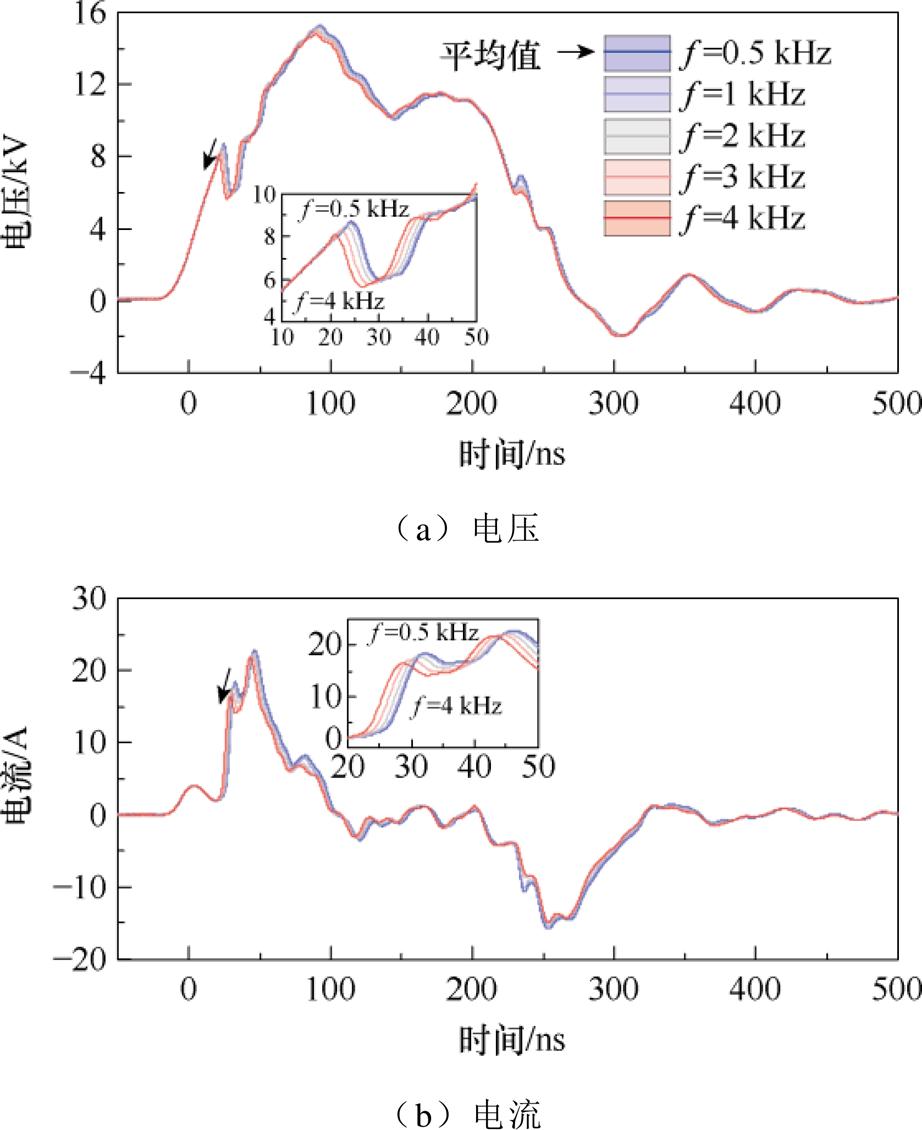
图9 不同脉冲频率下的电压和电流波形
Fig.9 Voltage and current waveforms under different pulse frequencies

图10 脉冲频率对上升沿和下降沿击穿电压、放电功率和谱线强度的影响
Fig.10 Breakdown voltage, discharge power, and emission intensities as a function of pulse frequency
不同湿度下的电压、电流波形如图11所示。整体而言,电压和电流的分散性较小,击穿时刻的电压和电流随湿度均有一定的提升。
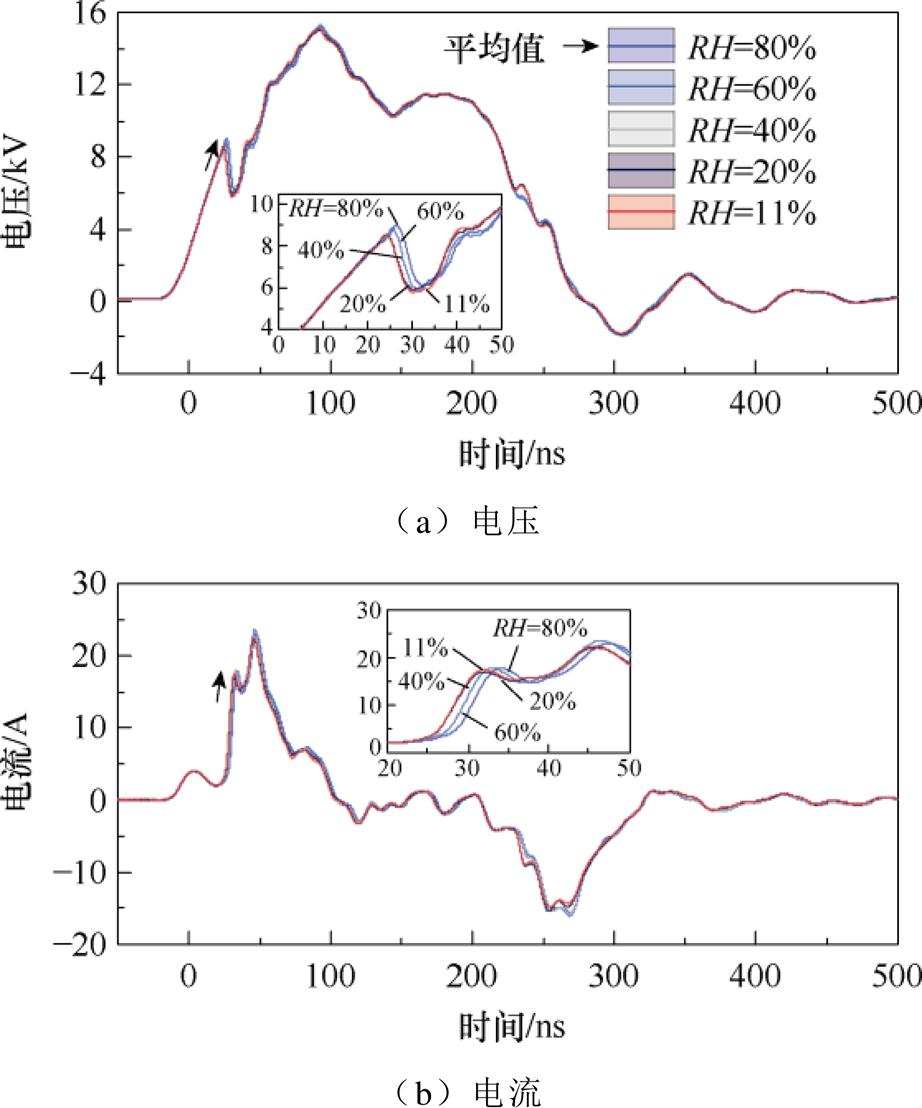
图11 不同气流湿度下的电压、电流波形
Fig.11 Voltage and current waveforms under different RH values
湿度对上升沿和下降沿击穿电压、放电功率和谱线强度的影响如图12所示。击穿电压随气流相对湿度的变化如图12a所示。上升沿和下降沿击穿电压与湿度近似呈线性关系。以上升沿为例,拟合得到Vb1=0.7RH+7.19 kV(R2=0.94),即完全干燥空气的击穿电压为7.19 kV,且相对湿度每上升20%,击穿电压提高0.14 kV,即击穿场强提高1.4 kV/cm。根据文献结果,对于1 cm间隙平行平板,水分子在空气中含量由0~2.2%(17 mmHg, 1 mmHg= 133.322 Pa),静态击穿电压由30 kV上升到31.5 kV,即升高5%[33]。对于本文结果,2.2%水蒸气含量对应相对湿度约为70%,对应击穿电压约为7.68 kV,与RH=0%相比升高6.8%,略高于文献值。这从另外一个角度说明,湿度对脉冲击穿的影响可能和对直流击穿的影响相当。同样地,拟合得到Vb2= 0.9RH+4.57 kV(R2=0.987),与上升沿相比,下降沿击穿电压受湿度的影响更大一些。
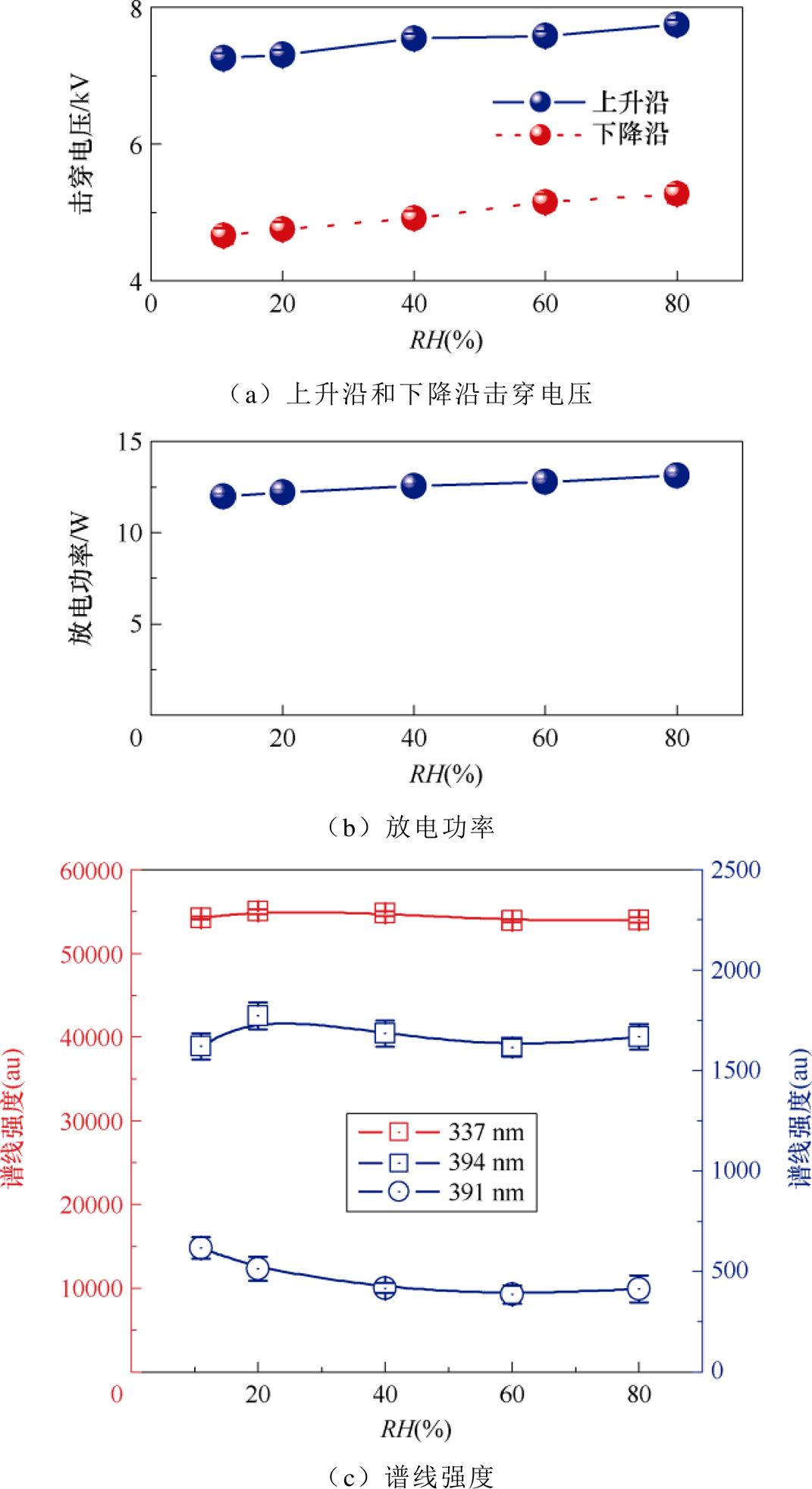
图12 湿度对上升沿和下降沿击穿电压、放电功率和谱线强度的影响
Fig.12 Breakdown voltages, discharge power, and emission intensities as a function of humidity
如图12b所示,放电功率随湿度增大而增大,意味着放电的沉积能量更多。放电功率近似和湿度呈线性关系(R2=0.990)。放电功率的提升与击穿电压提升有直接关系,而击穿电压提升的主要原因是水分子导致的附着系数的提高和有效电离系数的降低[34]。
此外,如图12c所示,氮气的337和394 nm发射谱线强度随着相对湿度的增加基本呈现降低趋势,表明激发态氮气分子含量降低,与以往文献关于体DBD[50]和表面DBD[51]的结果一致。需要指出的是,本文在高湿度条件下仍未观察到羟基自由基谱线。空气DBD的很多文献报道也没有通过发射光谱观察到羟基自由基谱带,可能原因是激发态OH很容易被空气中的N2和O2淬灭[2, 52-53]。
以放电功率为横坐标、337 nm的谱线强度为纵坐标绘制散点图,结果如图13所示。从图中可以看出,所有数据点分布在一条过零点的直线附近,这说明发射光谱强度与放电功率接近正比关系,与交流DBD的实验和仿真模拟结果一致[29]。主要原因是放电功率由焦耳加热项主导,而焦耳加热主要取决于电子密度和迁移速度,电子密度也与激发态粒子密度有正相关关系,因而最终导致该结果。事实上,除激发态粒子外,放电功率对其他活性粒子也具有类似的调控作用。仿真研究表明,在室温条件下,空气DBD中大多数活性粒子的密度或通量与放电功率呈线性关系[54]。需要强调的是,这种线性关系仅在一定条件下成立,通常对应于臭氧模式,即放电产生的长寿命粒子以臭氧为主。当放电功率密度和温度过高时,可能过渡到氮氧化物模式,此时长寿命活性粒子的生成特性会有显著不同,通常随时间呈现非线性变化[55-56]。
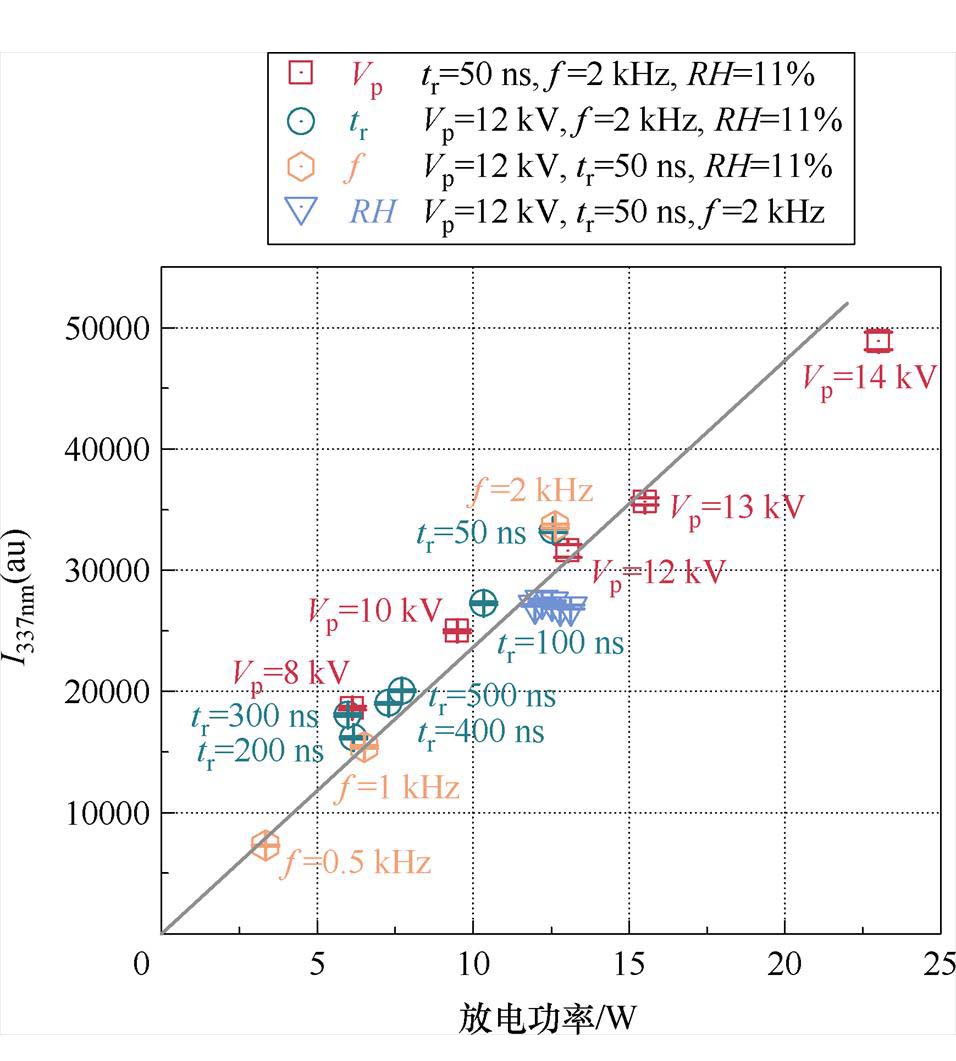
图13 不同条件下337 nm处谱线强度与放电功率关系
Fig.13 Scatter plot of emission intensities at 337 nm as a function of discharge power under different experimental conditions
气隙击穿特性是影响放电产生的活性粒子的主要因素之一。纳秒脉冲放电引起的气隙击穿通常可以用流注理论或逃逸电子理论解释。当脉冲上升沿足够短(如小于10 ns)或者脉冲击穿电压足够高(如大于5倍静态击穿电压)时,传统的流注理论已不再适用,需要考虑高能电子(≥150 eV)对击穿的贡献[57]。本文实验条件仍对应的是流注击穿。对于流注击穿,常用的击穿判据是Raether-Meek判据,简称Meek判据。Meek判据认为产生流注需要的电子数目应达到108~109(假设电子崩头部大小为106 mm3,则电子密度约为1014 cm-3)[58-59]。从单电子倍增的角度,应满足
 (3)
(3)
式中, 为有效电离系数;d为电子崩传播距离,即
为有效电离系数;d为电子崩传播距离,即 =[18, 21],记作K,称为倍增系数。注意,式(3)并未考虑电离系数随时间或位置的变化。从教科书可知,放电时延包含统计时延ts和放电形成时延tf。统计时延是指从电压达到静态击穿电压到形成第一个有效电子的时间;放电形成时延是指从有效电子形成到气隙完全击穿的时间[60]。从tf定义来看,该时间段应当包含初始电子崩、流注形成和流注跨接气隙三个阶段。可以通过分析初始电子崩并结合Meek判据,判断流注是否会形成。本文针对纳秒脉冲DBD的流注产生条件作如下推导。
=[18, 21],记作K,称为倍增系数。注意,式(3)并未考虑电离系数随时间或位置的变化。从教科书可知,放电时延包含统计时延ts和放电形成时延tf。统计时延是指从电压达到静态击穿电压到形成第一个有效电子的时间;放电形成时延是指从有效电子形成到气隙完全击穿的时间[60]。从tf定义来看,该时间段应当包含初始电子崩、流注形成和流注跨接气隙三个阶段。可以通过分析初始电子崩并结合Meek判据,判断流注是否会形成。本文针对纳秒脉冲DBD的流注产生条件作如下推导。
设电压波形为V(t),且有效电子位于阴极附近,则有效电子穿过整个气隙的倍增系数可以表示为
 (4)
(4)
式中, 是电场强度E的函数,E是关于电子崩位置x的函数,x可由电子崩迁移速度随时间积分得到;dg为气隙距离。
是电场强度E的函数,E是关于电子崩位置x的函数,x可由电子崩迁移速度随时间积分得到;dg为气隙距离。
 (5)
(5)
式中, 为电子崩迁移率,是关于电场强度的函数,在流注形成前,空间电荷电场并不显著,可以将电子崩迁移速度近似为电子迁移速度
为电子崩迁移率,是关于电场强度的函数,在流注形成前,空间电荷电场并不显著,可以将电子崩迁移速度近似为电子迁移速度 ,电子输运参数
,电子输运参数 和
和 可通过玻耳兹曼方程求解器BOLSIG+得到[61-63],气体组分为N2、O2和H2O,比例按照相对湿度计算,温度为298 K;tb为电子崩到达阳极的时刻,如果该时刻可形成流注,那么该时刻可近似为击穿时刻,对应的气隙击穿电压为V(tb)。此外,气隙电场强度可以由外加电压和DBD参数得到(不考虑介质表面电荷),有
可通过玻耳兹曼方程求解器BOLSIG+得到[61-63],气体组分为N2、O2和H2O,比例按照相对湿度计算,温度为298 K;tb为电子崩到达阳极的时刻,如果该时刻可形成流注,那么该时刻可近似为击穿时刻,对应的气隙击穿电压为V(tb)。此外,气隙电场强度可以由外加电压和DBD参数得到(不考虑介质表面电荷),有
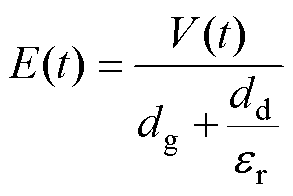 (6)
(6)
式(4)~式(6)构成非线性方程,未知数只有tb。假设RH=10%,K=20,V(t)=kt为线性变化,则气隙场强增长率为 ,其中,k为电压增长速率。不同气隙场强增长率下气隙击穿场强的模型计算结果如图14中的两条实线所示,分别对应ts=0和ts=5 ns,纵坐标为击穿场强E(tb)。这说明,击穿场强随电压增长速率的增大而增大,与以往研究结果一致[20]。此外,本文实验得到的上升沿击穿电压(不同幅值、上升沿、频率)基本在模型计算结果范围内。当场强增长率低于0.5 kV/(cm·ns)时,模型结果偏高,可能原因是模型仅考虑了单次电子崩而未考虑多次电子崩的贡献。Cui Yingzhe等的结果和本文结果的趋势基本一致[48];M. S. Simeni等的结果偏低,可能是放电统计时延较小导致[47]。
,其中,k为电压增长速率。不同气隙场强增长率下气隙击穿场强的模型计算结果如图14中的两条实线所示,分别对应ts=0和ts=5 ns,纵坐标为击穿场强E(tb)。这说明,击穿场强随电压增长速率的增大而增大,与以往研究结果一致[20]。此外,本文实验得到的上升沿击穿电压(不同幅值、上升沿、频率)基本在模型计算结果范围内。当场强增长率低于0.5 kV/(cm·ns)时,模型结果偏高,可能原因是模型仅考虑了单次电子崩而未考虑多次电子崩的贡献。Cui Yingzhe等的结果和本文结果的趋势基本一致[48];M. S. Simeni等的结果偏低,可能是放电统计时延较小导致[47]。
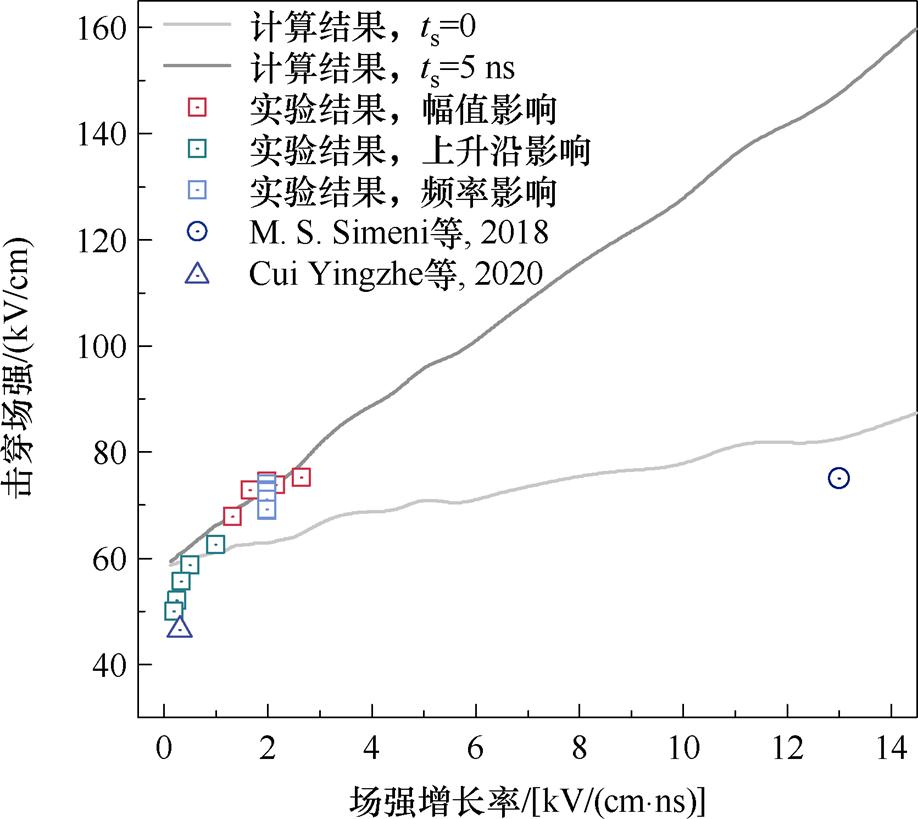
图14 气隙击穿场强随气隙场强增长率变化的实验结果、模型计算结果和文献[47-48]对比
Fig.14 Gap breakdown electric field as a function of gap electric field rise rate from experiments, model results, and Ref. [47-48]
上述模型可用于解释实验现象。当电压上升速率增加时,虽然电子崩迁移速率增加,但击穿前电子崩迁移(速度104~105 m/s)相对于外电场变化(ns级)为“慢过程”,导致电压上升速率越高,流注产生时刻的电压越高,即击穿电压越高。当频率升高时击穿电压下降,可以解释为统计时延的降低,即上次放电的残余带电粒子/亚稳态粒子更容易诱发产生种子电子,从而导致击穿电压降低。当湿度升高时击穿电压提高,可以解释为有效电离系数和电子迁移速率的降低,导致气隙在更长时间、即更高电压下才能击穿。本模型不局限于空气或介质阻挡放电,理论上可计算任意气体和任意放电结构的纳秒脉冲击穿电压。为更准确地预测击穿电压,模型需要进一步改进,如使用更复杂的流注判据、考虑多次电子崩的贡献、考虑介质表面电荷、实验估计统计时延等。
针对大气压湿空气条件下的单极性纳秒脉冲DBD放电,本文重点研究了其在不同参数条件下的电压电流、气隙击穿电压、放电功率和发射光谱特性,得到的结论如下:
1)随着外加电压幅值的提升(12~16 kV),气隙的上升沿、下降沿击穿电压和放电功率随之提高。放电功率和氮气谱线强度近似与电压峰值呈线性 关系。
2)随着脉冲上升和下降沿的增大(50~500 ns),上升沿击穿电压降低,而下降沿击穿电压先降低后增加,由此导致放电功率和氮气谱线强度在200~300 ns范围内存在极小值。
3)随着脉冲频率的提高(0.5~5 kHz),上升沿和下降沿击穿电压降低,单脉冲能量降低;氮气谱线强度近似和频率成正比。
4)随着湿度的增加(RH=11%~80%),上升沿和下降沿击穿电压和放电功率均随之线性提高。相对湿度每上升20%,上升沿的气隙击穿电压提高0.14 kV,击穿场强提高1.4 kV/cm。
5)在本文所有实验条件下,等离子体发射光谱的N2谱线强度与放电功率近似为正比关系,而受具体脉冲参数的影响较小。
6)基于本文模型可估算纳秒脉冲击穿电压,影响击穿的关键参量为电场变化率、统计时延和电子输运参数(有效电离系数和电子迁移率)。
本文可为空气纳秒脉冲DBD的放电和放电产物调控方法提供参考,为相关应用提供指导。
参考文献
[1] Zhang Longhui, Zhao Yulei, Zhou Xinchi, et al. Preparation of rGO/NiO nanocomposites by AC and nanosecond pulsed DBD[J]. Carbon, 2023, 214: 118377.
[2] Zhou Wu, Ye Zhiping, Nikiforov A, et al. The influ- ence of relative humidity on double dielectric barrier discharge plasma for chlorobenzene removal[J]. Journal of Cleaner Production, 2021, 288: 125502.
[3] 李亚龙, 杨照迪, 张英, 等. 介质阻挡放电对SF6降解产物SO2F2的无害化处理[J/OL]. 电工技术学报, DOI: 10.19595/j.cnki.1000-6753.tces.241116.
Li Yalong, Yang Zhaodi, Zhang Ying, et al. Dielectric barrier discharge on SF6 degradation products SO2F2 free-pollution disposal[J/OL]. Transactions of China Electrotechnical Society, DOI: 10.19595/j.cnki.1000- 6753.tces.241116.
[4] 商克峰, 曹无敌, 符梦辑. 电极结构对多孔陶瓷孔内微放电特性及苯降解的影响[J]. 电工技术学报, 2023, 38(6): 1687-1694.
Shang Kefeng, Cao Wudi, Fu Mengji. Effect of electrode configuration on microdischarge characteri- stics in porous ceramics and benzene degradation[J]. Transactions of China Electrotechnical Society, 2023, 38(6): 1687-1694.
[5] Guo Yuntao, Fang Mengqi, Zhang Liyang, et al. Study on flexible surface dielectric barrier discharge plasma film for in situ inactivation of bacteria and viruses[J]. Applied Physics Letters, 2022, 121(7): 074101.
[6] Zhang Liyang, Guo Yuntao, Chang Xuanyu, et al. In-duct grating-like dielectric barrier discharge system for air disinfection[J]. Journal of Hazardous Materials, 2022, 435: 129075.
[7] Wang Zifeng, Liu Linbo, Liu Dingxin, et al. Combination of NOx mode and O3 mode air dis- charges for water activation to produce a potent disinfectant[J]. Plasma Sources Science and Tech- nology, 2022, 31(5): 05LT01.
[8] 张浩, 张基珅, 许德晖, 等. 等离子体活化水溶液用于癌症治疗的研究综述[J]. 电工技术学报, 2023, 38(增刊1): 231-46.
Zhang Hao, Zhang Jishen, Xu Dehui, et al. Advances of plasma-activated solutions for cancer therapy[J]. Transactions of China Electrotechnical Society, 2023, 38(S1): 231-46.
[9] 刘定新, 张基珅, 王子丰, 等. 等离子体活化介质技术及其生物医学应用[J]. 电工技术学报, 2024, 39(12): 3855-68.
Liu Dingxin, Zhang Jishen, Wang Zifeng, et al. Plasma-activated media technology and its biomedical applications[J]. Transactions of China Electrotech- nical Society, 2024, 39(12): 3855-68.
[10] Li Yao, Qin Liang, Wang Hongli, et al. High effi- ciency NOx synthesis and regulation using dielectric barrier discharge in the needle array packed bed reactor[J]. Chemical Engineering Journal, 2023, 461: 141922.
[11] Mei Danhua, Zhang Peng, Duan Gehui, et al. CH4 reforming with CO2 using a nanosecond pulsed dielectric barrier discharge plasma[J]. Journal of CO2 Utilization, 2022, 62: 102073.
[12] 陈慧敏, 段戈辉, 梅丹华, 等. 气体添加对水电极同轴介质阻挡放电直接分解CO2的影响[J]. 电工技术学报, 2023, 38(1): 270-279, 284.
Chen Huimin, Duan Gehui, Mei Danhua, et al. Effect of gas addition on CO2 decomposition in a coaxial dielectric barrier discharge reactor with water elec- trode[J]. Transactions of China Electrotechnical Society, 2023, 38(1): 270-279, 284.
[13] 孙闵杰, 付军辉, 刘泓麟, 等. 分段电极介质阻挡放电CO2重整CH4过程放电特性与反应性能研究[J]. 电工技术学报, 2023, 38(15): 3972-3983.
Sun Minjie, Fu Junhui, Liu Honglin, et al. Discharge characteristics and reaction performance of CH4 reforming with CO2 in dielectric barrier discharge with segmented electrodes[J]. Transactions of China Electrotechnical Society, 2023, 38(15): 3972-3983.
[14] Yang Dezheng, Wang Wenchun, Zhang Shuai, et al. Atmospheric air homogenous DBD plasma excited by bipolar nanosecond pulse used for improving the hydrophilic property of polypropylene[J]. EPL (Europhysics Letters), 2013, 102(6): 65001.
[15] Wang Qian, Liu Feng, Miao Chuanrun, et al. Investigation on discharge characteristics of a coaxial dielectric barrier discharge reactor driven by AC and ns power sources[J]. Plasma Science and Technology, 2018, 20(3): 035404.
[16] Jiang Hui, Shao Tao, Zhang Cheng, et al. Comparison of AC and nanosecond-pulsed DBDs in atmospheric air[J]. IEEE Transactions on Plasma Science, 2011, 39(11): 2076-2077.
[17] Walsh J L, Shi J J, Kong M G. Contrasting characte- ristics of pulsed and sinusoidal cold atmospheric plasma jets[J]. Applied Physics Letters, 2006, 88(17): 171501.
[18] Williamson J M, Trump D D, Bletzinger P, et al. Comparison of high-voltage AC and pulsed operation of a surface dielectric barrier discharge[J]. Journal of Physics D: Applied Physics, 2006, 39(20): 4400- 4406.
[19] Zhang Xuming, Lee B J, Im H G, et al. Ozone production with dielectric barrier discharge: effects of power source and humidity[J]. IEEE Transactions on Plasma Science, 2016, 44(10): 2288-2296.
[20] Huang Bangdou, Takashima K, Zhu Ximing, et al. The influence of the voltage rise rate on the break- down of an atmospheric pressure helium nanosecond parallel-plate discharge[J]. Journal of Physics D: Applied Physics, 2015, 48(12): 125202.
[21] Komuro A, Ono R, Oda T. Effects of pulse voltage rise rate on velocity, diameter and radical production of an atmospheric-pressure streamer discharge[J]. Plasma Sources Science and Technology, 2013, 22(4): 045002.
[22] Wu Yun, Zhu Yifei, Cui Wei, et al. Simulation of nanosecond pulsed DBD plasma actuation with different rise times[J]. Plasma Processes and Poly- mers, 2015, 12(7): 642-654.
[23] Liu Feng, Li Shuhao, Zhao Yulei, et al. The effect of pulse voltage rise rate on the polypropylene surface hydrophilic modification by ns pulsed nitrogen DBD[J]. Plasma Science and Technology, 2023, 25(10): 104001.
[24] Wu S, Xu H, Lu X, et al. Effect of pulse rising time of pulse DC voltage on atmospheric pressure non- equilibrium plasma[J]. Plasma Processes and Poly- mers, 2013, 10(2): 136-140.
[25] Huang Bangdou, Takashima K, Zhu Ximing, et al. The influence of the repetition rate on the nanosecond pulsed pin-to-pin microdischarges[J]. Journal of Physics D Applied Physics, 2014, 47(42): 422003.
[26] Shao Tao, Long Kaihua, Zhang Cheng, et al. Elec- trical characterization of dielectric barrier discharge driven by repetitive nanosecond pulses in atmospheric air[J]. Journal of Electrostatics, 2009, 67(2/3): 215- 221.
[27] Li Yutai, Li Handong, Liu Zhigang, et al. Breakdown, discharge modes, and gaseous recovery of atmo- spheric air with repetitive 10 ns pulses[J]. Physics of Plasmas, 2021, 28(7): 073510.
[28] Pan Guangsheng, Tan Zhenyu, Pan Jie, et al. A comparative study on the frequency effects of the electrical characteristics of the pulsed dielectric barrier discharge in He/O2 and in Ar/O2 at atmo- spheric pressure[J]. Physics of Plasmas, 2016, 23(4): 043508.
[29] Zhang Liyang, Liu Zhigang, Guo Yuntao, et al. Kinetic model of grating-like DBD fed with flowing humid air[J]. Plasma Sources Science and Technology, 2024, 33(2): 025001.
[30] Lu Chen, Peng Tao, Xiong Zilan. Operation-mode recognition of surface microdischarge based on visible image and deep learning[J]. Journal of Physics D: Applied Physics, 2022, 55(30): 305202.
[31] Abdel-Salam M. Positive wire-to-plane coronas as influenced by atmospheric humidity[J]. IEEE Transa- ctions on Industry Applications, 1985, IA-21(1): 35-40.
[32] Aleksandrov N L. Three-body electron attachment to a molecule[J]. Soviet Physics Uspekhi, 1988, 31(2): 101-118.
[33] Kuffel E. Influence of humidity on the breakdown voltage of sphere-gaps and uniform-field gaps[J]. Proceedings of the IEE Part A: Power Engineering, 1961, 108(40): 295.
[34] Li Bingxu, Li Xingwen, Fu Mingli, et al. Effect of humidity on dielectric breakdown properties of air considering ion kinetics[J]. Journal of Physics D: Applied Physics, 2018, 51(37): 375201.
[35] Sarinont T, Amano T, Attri P, et al. Effects of plasma irradiation using various feeding gases on growth of Raphanus sativus L[J]. Archives of Biochemistry and Biophysics, 2016, 605: 129-140.
[36] Ki S H, Masur K, Baik K Y, et al. Effects of humidity on room disinfection by dielectric barrier discharge plasma[J]. Journal of Physics D Applied Physics, 2019, 52(42): 425204.
[37] Hähnel M, von Woedtke T, Weltmann K D. Influence of the air humidity on the reduction of Bacillus spores in a defined environment at atmospheric pressure using a dielectric barrier surface discharge[J]. Plasma Processes and Polymers, 2010, 7(3/4): 244-249.
[38] Patil S, Moiseev T, Misra N N, et al. Influence of high voltage atmospheric cold plasma process parameters and role of relative humidity on inactivation of Bacillus atrophaeus spores inside a sealed package[J]. Journal of Hospital Infection, 2014, 88(3): 162- 169.
[39] Kogelheide F, Voigt F, Hillebrand B, et al. The role of humidity and UV-C emission in the inactivation of B. subtilis spores during atmospheric-pressure die- lectric barrier discharge treatment[J]. Journal of Physics D: Applied Physics, 2020, 53(29): 295201.
[40] Zhang Liyang, Guo Yuntao, Tie Jinfeng, et al. Grating-like DBD plasma for air disinfection: dose and dose-response characteristics[J]. Journal of Hazardous Materials, 2023, 447: 130780.
[41] Staack D, Farouk B, Gutsol A, et al. Characterization of a DC atmospheric pressure normal glow dis- charge[J]. Plasma Sources Science and Technology, 2005, 14(4): 700-711.
[42] Zhang Li, Yang Dezheng, Wang Wenchun, et al. Needle-array to plate DBD plasma using sine AC and nanosecond pulse excitations for purpose of improving indoor air quality[J]. Scientific Reports, 2016, 6: 25242.
[43] Qi Haicheng, Fan Zhihui, Liu Yidi, et al. Investi- gation of nanosecond pulsed dielectric barrier dis- charge using plate-to-plate electrode with asymmetric dielectric arrangement in airflow[J]. Physics of Plasmas, 2016, 23(5): 053509.
[44] Paris P, Aints M, Valk F, et al. Intensity ratio of spectral bands of nitrogen as a measure of electric field strength in plasmas[J]. Journal of Physics D Applied Physics, 2005, 38(21): 3894-3899.
[45] Shao Tao, Long Kaihua, Zhang Cheng, et al. Experi- mental study on repetitive unipolar nanosecond-pulse dielectric barrier discharge in air at atmospheric pressure[J]. Journal of Physics D Applied Physics, 2008, 41(21): 215203.
[46] Ambrico P F, Aceto D, Ibba L, et al. Breakdown development in a nanosecond pulsed dielectric barrier discharge in humid air in plane-to-plane geometry[J]. Plasma Sources Science and Technology, 2023, 32(9): 095008.
[47] Simeni M S, Goldberg B, Gulko I, et al. Sub- nanosecond resolution electric field measurements during ns pulse breakdown in ambient air[J]. Journal of Physics D: Applied Physics, 2018, 51(1): 01LT01.
[48] Cui Yingzhe, Wang Hao, Zhuang Chijie, et al. Electric field measurement in dielectric barrier dis- charges using electric field induced second harmonic generation in ambient air[J]. IEEE Transactions on Dielectrics and Electrical Insulation, 2020, 27(6): 2071-2077.
[49] Shao Tao, Sun Guangsheng, Yan Ping, et al. Breakdown phenomena in nitrogen due to repetitive nanosecond-pulses[J]. IEEE Transactions on Die- lectrics and Electrical Insulation, 2007, 14(4): 813-819.
[50] Deng Jun, He Liming, Zhao Bingbing, et al. Effects of air relative humidity on spectral characteristics of dielectric barrier discharge plasma assisted com- bustion reactor[J]. Vacuum, 2020, 175: 109189.
[51] Abdelaziz A A, Ishijima T, Seto T. Humidity effects on surface dielectric barrier discharge for gaseous naphthalene decomposition[J]. Physics of Plasmas, 2018, 25(4): 043512.
[52] Eto H, Ono Y, Ogino A, et al. Low-temperature sterilization of wrapped materials using flexible sheet-type dielectric barrier discharge[J]. Applied Physics Letters, 2008, 93(22): 221502.
[53] Ye Zhiping, Veerapandian S K P, Onyshchenko I, et al. An in-depth investigation of toluene decom- position with a glass beads-packed bed dielectric barrier discharge reactor[J]. Industrial & Engineering Chemistry Research, 2017, 56(37): 10215-10226.
[54] 张丽阳, 郭云涛, 帖金凤, 等. 大气压栅状介质阻挡放电等离子体空气消毒研究[J]. 高电压技术, 2024, 50(7): 2972-2987.
Zhang Liyang, Guo Yuntao, Tie Jinfeng, et al. Air disinfection by atmospheric pressure grating-like dielectric barrier discharge plasma[J]. High Voltage Engineering, 2024, 50(7): 2972-2987.
[55] Pavlovich M J, Clark D S, Graves D B. Quantification of air plasma chemistry for surface disinfection[J]. Plasma Sources Science and Technology, 2014, 23(6): 065036.
[56] Liu Kun, Geng Wenqiang, Zhou Xiongfeng, et al. Transition mechanisms between selective O3 and NOx generation modes in atmospheric-pressure plasmas: decoupling specific discharge energy and gas temperature effects[J]. Plasma Sources Science and Technology, 2023, 32(2): 025005.
[57] 李雨泰, 刘志刚, 付洋洋, 等. 逃逸电子对纳秒短脉冲大气压空气击穿的影响[J]. 高电压技术, 2023, 49(12): 5228-5236.
Li Yutai, Liu Zhigang, Fu Yangyang, et al. Effect of runaway electrons on the breakdown of nanosecond short pulse in atmospheric air[J]. High Voltage Engineering, 2023, 49(12): 5228-5236.
[58] Montijn C, Ebert U. Diffusion correction to the Raether-Meek criterion for the avalanche-to-streamer transition[J]. Journal of Physics D: Applied Physics, 2006, 39(14): 2979.
[59] Bluhm H. Pulsed Power Systems: Principles and Applications[M]. Springer: Berlin/Heidelberg, 2006.
[60] 梁曦东, 周远翔, 曾嵘. 高电压工程[M]. 2版. 北京: 清华大学出版社, 2015: 55.
[61] Hagelaar G J M, Pitchford L C. Solving the Boltzmann equation to obtain electron transport coefficients and rate coefficients for fluid models[J]. Plasma Sources Science Technology, 2005, 14(4): 722-733.
[62] Hösl A, Häfliger P, Franck C M. Measurement of ionization, attachment, detachment and charge trans- fer rate coefficients in dry air around the critical electric field[J]. Journal of Physics D: Applied Physics, 2017, 50(48): 485207.
[63] An Yunzhu, Su Menghan, Hu Yuanchao, et al. The influence of humidity on electron transport para- meters and insulation performance of air[J]. Frontiers in Energy Research, 2022, 9: 806595.
Atmospheric Pressure Nanosecond Pulsed Dielectric Barrier Discharge in Humid Air
Abstract Atmospheric pressure dielectric barrier discharge (DBD) is an emerging technology with significant potential for environmental and biomedical applications. Compared to alternating-current (AC) DBD, nanosecond pulsed DBD demonstrates several unique advantages, including lower operational temperature, improved discharge uniformity, and higher electron energy. These attributes are particularly advantageous for enhancing the generation of reactive species. Previous research has primarily examined the influence of individual pulse parameters (e.g., voltage amplitude and pulse frequency) on pulsed DBD performance. However, comprehensive investigations comparing multiple parameters, particularly the role of discharge power in reactive species generation, remain scarce. Furthermore, while it is well-established that humidity affects electron attachment and ionization thresholds, its quantitative impact on the breakdown dynamics and plasma chemistry of nanosecond-pulsed DBDs has not been thoroughly studied.
This study explores the discharge characteristics and emission spectral properties of a nanosecond-pulsed parallel-plate DBD operating in humid air. An equivalent circuit model was utilized to calculate gap breakdown voltages during the pulse's rising and falling phases. Additionally, optical emission spectroscopy (OES) was employed to characterize the behavior of reactive species.
Increasing the pulse voltage amplitude (8~16 kV) raises both the rising-edge (6.8~7.5 kV) and falling-edge (3.7~6.9 kV) breakdown voltages, with discharge power increasing proportionally (6.1~23 W). Extending the pulse rise/fall time (50~500 ns) reduces the rising-edge breakdown voltage (7.2~5.0 kV) but results in a local minimum for both the falling-edge breakdown voltage and discharge power at 200~300 ns. The increased breakdown voltage with the rising voltage rate has been widely reported and is attributed to the characteristic breakdown delay time associated with nanosecond-pulsed voltages. In contrast, the observed increase in fall-edge breakdown voltage and discharge power within the pulse rise time of 300~500 ns may result from the longer time interval between the rising and falling edges, which allows for gradual recovery of gas insulation, including gas density restoration and electrical neutrality re-establishment. Higher pulse frequencies (0.5~5 kHz) decrease breakdown voltages (7.4~6.9 kV) and single-pulse energy, leading to a weaker linear dependence of discharge power on pulse frequency. Additionally, both breakdown voltage and discharge power increase with humidity, while plasma emission decreases principally due to the quenching reactions induced by water molecules. In dry air (1 mm gap), the rising-phase breakdown voltage is approximately 7.19 kV, increasing by 0.14 kV for every 20% rise in relative humidity (RH).
In summary, discharge power positively correlates with gap breakdown voltage under all conditions. It is also found that nitrogen emission intensities exhibited a near-linear proportionality to discharge power across all conditions, regardless of specific pulse parameters. This universal relationship highlights discharge power as a potential control parameter for regulating plasma chemistry. Given the critical role of breakdown voltage, a simplified streamer-based framework was developed to predict the pulsed breakdown voltage. By integrating Raether-Meek criteria and electron transport parameters (derived from Boltzmann equation solvers), the model successfully predicts breakdown voltages under varying gap electric field rise rates (0.5~2 kV/cm·ns). Experimental validation confirmed its alignment with observed trends.
In conclusion, this study enhances the understanding of nanosecond-pulsed DBDs in humid environments by clarifying the interrelationships between pulse parameters, humidity, and plasma emission behaviors. The observed linear correlation between discharge power and nitrogen emission intensity offers a scalable approach for optimizing reactive species generation. Moreover, the proposed model enables breakdown voltage estimation under a pulsed power excitation, supporting the development of energy-efficient plasma systems and the precise control of reactive species under real-world atmospheric conditions.
Keywords:Atmospheric pressure, humid air, nanosecond pulsed, dielectric barrier discharge (DBD)
中图分类号:TM614
DOI: 10.19595/j.cnki.1000-6753.tces.240716
国家自然科学基金(52407176)和国家资助博士后研究人员计划(GZB20230326)资助项目。
收稿日期2024-05-07
改稿日期 2024-11-15
王 凯 1995年生,硕士,研究方向为低温等离子体及其应用。
E-mail: wk_wake@163.com
张丽阳 1996年生,助理研究员,研究方向为低温等离子体及其应用。
E-mail: zhang_ly@tsinghua.edu.cn(通信作者)
(编辑 崔文静)